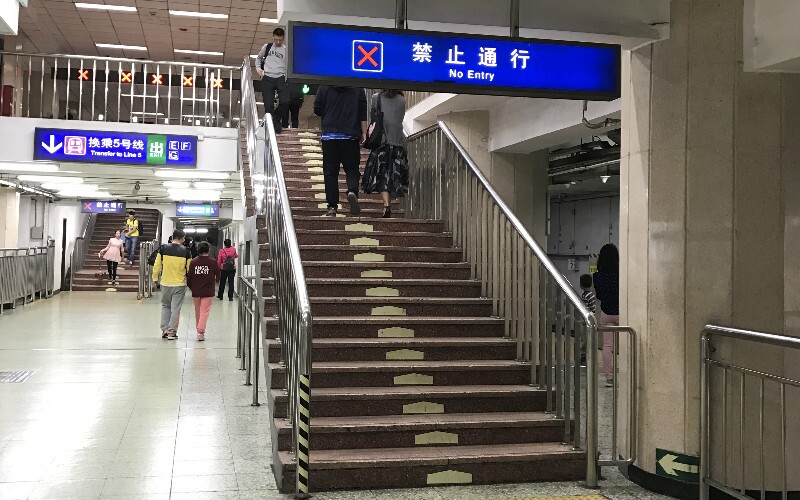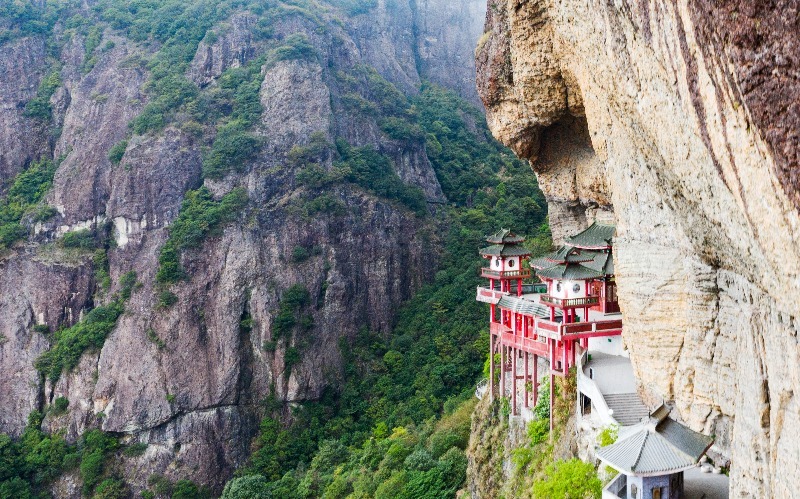Beijing Subway Line 2, also called the Ring Line, runs the rectangular shape of Beijing's Second Ring Road.
Major Stops on Line 2
- Xizhimen (西直门): Jiamao Shopping Center. (Also see the best shopping streets in Beijing.)
- Qianmen (前门): Qianmen Street
- Yonghegong (雍和宫): Yonghe Lama Temple
Transfer Stations on Line 2
- Fuxingmen (复兴门) and Jianguomen (建国门) for Subway Line 1
- Xuanwumen (宣武门) and Xizhimen (西直门) for Line 4
- Chongwenmen (崇文门) and Yonghegong (雍和宫) for Line 5
- Dongzhimen (东直门) and Xizhimen (西直门) for the Airport Express Line and Line 13
Train Times
| Station | Outer Ring (Xizhimen to Jishuitan) | Inner Ring (Jishuitan to Xizhimen) | ||||
|---|---|---|---|---|---|---|
| First Train | Last Train | First Train | Last Train | |||
| To Jishuitan | To Gulou Dajie | To Xizhimen | To Chegongzhuang | |||
| Xizhimen | 05:09 | 22:14 | 22:59 | 05:33 | 22:41 | ---- |
| Chegongzhuang | 05:11 | 22:16 | 23:01 | 05:30 | 22:34 | 23:24 |
| Fuchengmen | 05:13 | 22:18 | 23:03 | 05:28 | 22:32 | 23:22 |
| Fuxingmen | 05:16 | 22:21 | 23:06 | 05:25 | 22:29 | 23:19 |
| Changchunjie | 05:18 | 22:23 | 23:08 | 05:22 | 22:27 | 23:16 |
| Xuanwumen | 05:20 | 22:25 | 23:10 | 05:20 | 22:25 | 23:14 |
| Hepingmen | 05:22 | 22:27 | 23:12 | 05:18 | 22:23 | 23:12 |
| Qianmen | 05:24 | 22:29 | 23:14 | 05:16 | 22:21 | 23:10 |
| Chongwenmen | 05:26 | 22:31 | 23:16 | 05:13 | 22:18 | 23:08 |
| Beijing Railway Station | 05:13 | 22:35 | 23:20 | 05:10 | 22:15 | 23:05 |
| Jianguomen | 05:16 | 22:37 | 23:22 | 05:20 | 22:13 | 23:02 |
| Chaoyangmen | 05:18 | 22:40 | 23:25 | 05:17 | 22:10 | 22:59 |
| Dongsishitiao | 05:20 | 22:42 | 23:27 | 05:15 | 22:08 | 22:57 |
| Dongzhimen | 05:23 | 22:44 | 23:29 | 05:13 | 22:06 | 22:55 |
| Yonghegong | 05:26 | 22:48 | 23:33 | 05:09 | 22:02 | 22:51 |
| Andingmen | 05:28 | 22:50 | 23:35 | 05:07 | 22:00 | 22:49 |
| Gulou Dajie | 05:30 | 22:52 | 23:37 | 05:05 | 21:58 | 22:47 |
| Jishuitan | 05:33 | 22:55 | ---- | 05:03 | 21:55 | 22:45 |
Attractions along the Beijing Subway Line 2
Jishuitan Station 积水潭站
The nearby attractions: Jishuitan Lake 积水潭, Guo Shoujing Memorial Hall 郭守敬纪念馆
Jishuitan Station is located beside Jishuitan Lake on the west side of Deshengmen Street 德胜门西大街. The lake and Guo Shoujing Memorial Hall are close to the station. Guo Shoujing was a famous Chinese astronomer and hydrologist in the Yuan Dynasty. There are also many public transportation lines around Jishuitan Station, so it's very convenient to go to Xin Jiekou and Deshengmen from there.
Gulou Street Station 鼓楼大街站
 the Bell and Drum Towers
the Bell and Drum TowersThe nearby attractions: the Bell and Drum Towers 钟楼鼓楼, Yandaixie Street 烟袋斜街,Shichahai 什刹海
Gulou Street Station is located in the North Second Ring Road, to the north of the Bell and Drum Towers.
The Bell and Drum Towers
The Bell and Drum Towers are a group of ancient buildings located to the north of Beijing's north-south central axis, being the central point for striking the time in the Yuan, Ming and Qing dynasties.
Shichahai
Shichahai, located to the south-west of the Bell and Drum Towers, is a popular tourist place in Beijing. With so many historical sites, bars and restaurants, it has become a must-see destination for people visiting Beijing.
- 6-Day Beijing Winter Tour with Skiing in a 2022 Olympic Winter Games Venue
- 1-Day In-Depth Beijing Culture Tour
Andingmen Station 安定门站
The nearby attraction: Ditan Park 地坛公园
Ditan Park
Walk to the north from Andingmen Station, then you will arrive at Ditan (the Temple of Earth), which was the famous garden for sacrificial ceremonies in the Ming and Qing dynasties. Ditan, a solemn and quaint royal temple, was the place where the Chinese Earth God and some other Chinese gods were worshiped by emperors in the Ming and Qing dynasties. It is also the biggest existing temple for sacrificial ceremonies in China. Now there are still many well-preserved Ming and Qing buildings there. During the Spring Festival of each year, a temple fair is held and other cultural activities are displayed in the park.
Yonghegong Station 雍和宫站
The nearby attractions: the Imperial Academy 国子监, the Yonghe Lama Temple 雍和宫,the Confucian Temple 孔庙
The Imperial Academy
 The Imperial Academy
The Imperial AcademyThe Imperial Academy is located in Andingmen in the Dongcheng District of Beijing. Built in the 10th year of the Dade Period during the Yuan Dynasty, it was the highest educational administration and the highest academy in the country during the Yuan, Ming and Qing dynasties. There are Chinese scholar trees on both sides of the Imperial Academy Street; at the east and west ends, as well as both sides of the front door, of the academy are color-painted decorated archways. It is the only ancient street with four archways left in Beijing.
The Yonghe Lama Temple
The Yonghe Lama Temple, located in the east part of Yonghegong Street, at the north-east corner of the inner city in Dongcheng District of Beijing, is the biggest Lama Buddhist temple in Beijing. It occupies an area of 66,400 square meters and possesses over 1,000 palaces. It was first built in the Kangxi years of the Qing Dynasty, enjoying a history of over 300 years.
The Confucian Temple
The Confucian Temple, located in Guozijian Street of Dongcheng District, was the place to offer sacrifices to Confucius in the Yuan, Ming and Qing dynasties. The Dacheng Palace inside was just the right place for holding sacrificial ceremonies. The ritual and musical instruments are still set out as they originally were in the palace, reproducing the scenes of worshiping Confucius and dancing with music in those years.
Chaoyangmen Station 朝阳门站
 The Dongyue Temple
The Dongyue TempleThe nearby attraction: the Dongyue Temple 东岳庙
The Dongyue Temple
The Dongyue Temple, first built in the 6th year of the Yuanyan Period (1319), is located outside Chanyangmen 朝阳门外. The temple features rich statues of gods and Buddhas, stone tablets and couplets. There are over 3,000 statues in the temple, and all the statues, in different postures and manners, are vivid and lively.
Jianguomen Station 建国门站
The nearby attraction: the Ancient Observatory 古天文台
The Ancient Observatory
The Ancient Observatory in Beijing, located in the south-west corner of Jianguomen, was built in the Zhengtong years of the Ming Dynasty (1436-1450). It is one of the most ancient observatories in the world. Being called "Star Observation Platform" in the Ming Dynasty, it was equipped with abridged armillas, armillary spheres, celestial globes and other large astronomical instruments on the top, and a gnomon and a clepsydra at the bottom. In the Qing Dynasty, it was renamed "The Observatory", and after the Revolution of 1911 it was renamed "The Central Star Observation Platform". It is famous for its perfect buildings, exquisite equipment and long history. Now, it is the location of the Beijing Astronomical Instrument Exhibition Hall.
- 4-Day Beijing Private Tour to Visit the Great Wall at Night
- Half-Day Beijing Walking Tour in a Neighborhood
Qianmen Station 前门站
The nearby attractions: Qianmen Street 前门大街, Qianmen 前门, the Qianmen Old Station 前门老车站
The area around Qianmen Station is a good place to experience the charms of old Beijing. There are the quaint and majestic gates of Zhengyangmen, the Qianmen Old Station buildings in a European style, as well as the Dazhanlan Business Street clustered with many shops of 100-year-old brands.
Besides, visitors can also visit the Badaling Great Wall, the Ming Tombs, the Juyongguan Great Wall and other attractions from there by bus.
Hepingmen Station 和平门站
 Liulichang Cultural Street
Liulichang Cultural StreetThe nearby attraction: Liulichang Cultural Street 琉璃厂文化街
Liulichang Cultural Street
Liulichang Cultural Street, located outside Hepingmen Street of Beijing, is a famous cultural street in Beijing. It originated from the Qing Dynasty. At that time, the provincial graduates from all over the country who visited the capital for the imperial examination mostly lived there, so there were many shops selling books and writing brushes, ink sticks, paper and inkstones, gradually forming a thick cultural atmosphere. There are a lot of shops selling antiques, calligraphies and paintings now, and most of the foreign visitors will go there.
In addition, the Zhengyici 正乙祠 and Guguang Guild Hall 湖广会馆 which are not far from there are both good places to enjoy the Beijing Opera.
Fuchengmen Station 阜成门站
The nearby attraction: Lu Xun Museum 鲁迅博物馆
Lu Xun Museum
The area around Fuchengmen Station is a business zone with a rich breath of life in Beijing. Lu Xun Museum is located near the station. Lu Xun was China's great littérateur and thinker. Lu Xun Museum was built in 1956, and it has collected over 30,000 cultural objects. Lu Xun's former residence in the museum was designed and built by Lu Xun himself in 1924 and has been well preserved.
Back to Beijing Subway









